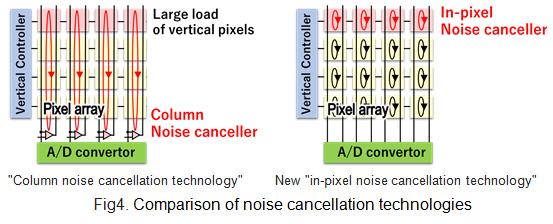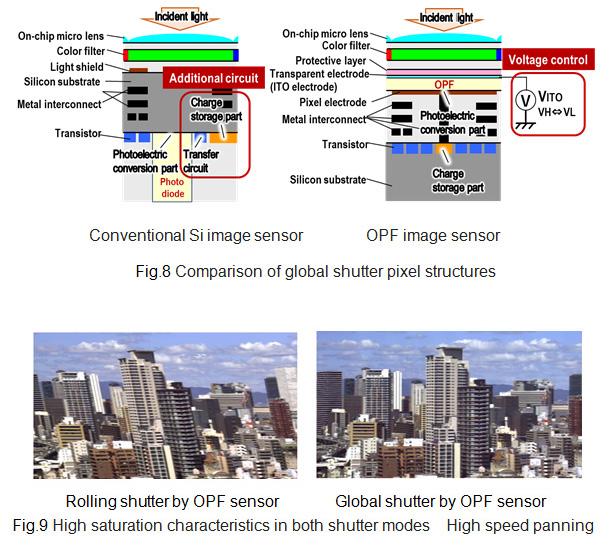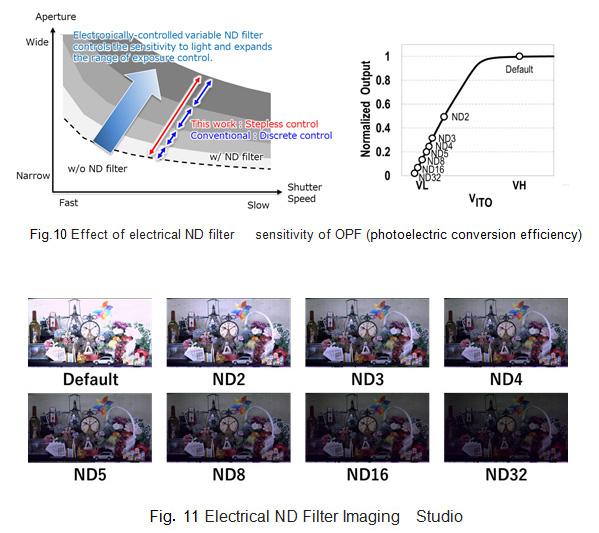A recent blog post by Panasonic discusses the color quality of their organic CMOS image sensor.
Link: https://news.panasonic.com/global/topics/13982
Osaka, Japan – Panasonic Holdings Corporation announced that it has developed excellent color reproduction technology that suppresses color crosstalk by thinning the photoelectric conversion layer using the high light absorption rate of the Organic Photoconductive File (OPF) and by using electrical pixel separation technology. In this technology, the OPF part that performs photoelectric conversion and the circuit part that stores and readouts the electric charge are completely independent. This unique layered structure dramatically reduces the sensitivity of each pixel in green, red, and blue in wavelength regions outside the target range. As a result, color crosstalk is reduced, excellent spectral characteristics are obtained, and accurate color reproduction is made possible regardless of the type of light source.
Conventional Bayer array-type silicon image sensors do not have sufficient color separation performance for green, red, and blue. Therefore, for example, under light sources that have peaks at specific wavelengths, such as cyan light and magenta light, it has been difficult to accurately reproduce, recognize, and judge colors.
Our OPF CMOS image sensor has a unique structure in which the photoelectric conversion part that converts light into an electric signal is an organic thin film, and the function of storing and reading out the signal charge is performed in the circuit part, which are completely independent from each other (Figure 1). As a result, unlike with conventional silicon image sensors, it is possible to provide photoelectric conversion characteristics that do not depend on the physical properties of silicon. The OPF with its high light absorption rate enables the thinning of the photoelectric conversion part ((1) Photoelectric conversion film thinning technology). By providing a discharge electrode at the pixel boundaries, the signal charge due to the incident light at the pixel boundaries is discharged, and the signal charge from adjacent pixels is suppressed ((2) Electrical pixel isolation technology). In addition, since the under part of the OPF is covered with the pixel electrode for collecting the signal charge generated in the OPF and the electrode for discharging the charge, incident light that cannot be absorbed by the OPF does not reach the circuit side. This suppresses the transmission ((3) Light transmission suppression structure). With the above three technologies, it is possible to suppress light and signal charges that enter from adjacent pixels. As a result, color crosstalk can be reduced to an almost ideal shape, as shown in the spectral characteristics shown in Figure 2, and accurate color reproduction is achieved regardless of the color of the light source (Figure 3).
This technology enables accurate color reproduction and inspection even in environments where it is difficult for conventional image sensors to reproduce the original colors, such as plant factories that use magenta light. It is also possible to accurately reproduce the colors of substances with subtle color changes, such as living organisms. It can also be applied to managing skin conditions, monitoring health conditions, and inspecting fruits and vegetables. Furthermore, in combination with the high saturation characteristics and global shutter function of our OPF CMOS image sensor*, it can contribute to highly robust imaging systems that are highly tolerant of changes in light source type, illuminance, and speed.
This sensor has been under development for many years. Panasonic's press release from 2018 demonstrated the dynamic range and speed: https://news.panasonic.com/global/press/en180214-2
Panasonic Develops Industry's-First 8K High-Resolution, High-Performance Global Shutter Technology using Organic-Photoconductive-Film CMOS Image Sensor
The new technology enables 8K high resolution and high picture quality imaging without motion distortion, even in extremely bright scenes.
Osaka Japan, - Panasonic Corporation today announced that it has developed a new technology which realizes 8K high-resolution (36M pixels), 60fps framerate, 450k high-saturation electrons and global shutter [1] imaging with sensitivity modulation function simultaneously, using a CMOS image sensor with an organic photoconductive film (OPF). In this OPF CMOS image sensor, the photoelectric-conversion part and the circuit part are independent. By utilizing this OPF CMOS image sensor's unique structure, we have been able to newly develop and incorporate high-speed noise cancellation technology and high saturation technology in the circuit part. And, by using this OPF CMOS image sensor's unique sensitivity control function to vary the voltage applied to the OPF, we realize global shutter function. The technology that simultaneously achieves these performances is the industry's first*1.
With the technology, it is possible to capture images at 8K resolution, even in high contrast scenes, such as a field under strong sunlight and shaded spectator seats under a stadium roof. Moreover, by utilizing the global shutter function that enables simultaneous image capture by all pixels, it is expected to be able to capture moving objects instantaneously without distortion, be utilized for multi viewpoint cameras (performing multi-view synchronized imaging using plural cameras) and used in fields requiring high-speed and high-resolution, such as machine vision and ITS monitoring. In addition, conventionally, even in scenes where it was necessary to utilize different ND filters [2] according to capturing conditions, the technology realizes a new electronically-controlled variable ND filter function which enables stepless adjustment of the OPF sensitivity [3] merely by controlling the voltage applied to the OPF.
The new technology has the following advantages.
- 8K resolution, 60fps framerate, 450k saturation electrons and global shutter function are realized simultaneously.
- Switching between high sensitivity mode and high saturation mode is possible using gain switching function.
- The ND filter function can be realized steplessly by controlling the voltage applied to the OPF.
This Development is based on the following technologies.
- "OPF CMOS image sensor design technology", in that, the photoelectric-conversion part and the circuit part can be designed independently.
- "In-pixel capacitive coupled noise cancellation technique" which can suppress pixel reset noise at high speed even at high resolution
- "In-pixel gain switching technology" that can achieve high saturation characteristics
- "Voltage controlled sensitivity modulation technology" that can adjust the sensitivity by changing the voltage applied to the OPF.
Panasonic holds 135 Japanese patents and 83 overseas patents (including pending) related to this technology.
Panasonic will present some of these technologies at the international academic conference: ISSCC (International Solid-State Circuit Conference) 2018 which will be held in San Francisco on February 11 - 15, 2018.







No comments:
Post a Comment
All comments are moderated to avoid spam and personal attacks.